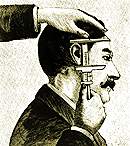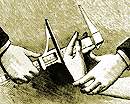 |

|
|

| |||||||
 Don't miss the season premiere of Medical Detectives on TLC. 
Alphonse Bertillon, as catalogued in the system he invented. Click to see a larger image. 
Bertillon's police superiors thought he was a bit nuts -- until they used his data to identify nearly 800 suspects in three years. 
What doomed the Bertillon system was unsettling proof of its fallibility. 
Today the once-famous Bertillon is virtually forgotten. |
Alphonse
Bertillon and the Science of Criminal Identification
By Patrick J. Kiger
In 1903 a newly convicted prisoner named Will West arrived at Leavenworth Prison, and was escorted by guards to the office. There they measured his height and the expanse of his arms and wrapped a pair of steel calipers around his head. After that they noted the length of his right ear, left foot, left forearm and selected fingers. They examined the size and shape of his nose, measured the tilt of his forehead and examined his skin for scars and blemishes. All were dutifully recorded on an index card -- establishing Will West's identity under the Bertillon System. Bertillonage was the brainchild of Alphonse Bertillon, who started with the Paris police department in 1879 as a clerk. He had absorbed some scientific knowledge from his father, an anthropologist who had labored to prove that each human being had unique variations in physical characteristics. Young Bertillon quickly saw that his father's academic obsession might have practical value in police work, where detectives had trouble seeing past the disguises and aliases affected by criminals. Bertillon began using his father's measuring techniques on arrestees and convicts, fastidiously recording the data on cards. He developed a filing system that put a person in one of three main categories based upon head size. He then subdivided them further according to the dimensions of the left middle finger, and so on down the line, using 11 different bodily measurements. Bertillon had calculated that the probability of two people having precisely the same 11 measurements was one in four million. A criminal might wear a fake beard or give a phony name, but Bertillon noted that "subjects cannot exercise the slightest influence on their cranium diameters." His police superiors thought he was a bit nuts, until they used his data successfully to identify nearly 800 suspects in three years. In French courts, where suspects were guilty until proven otherwise, proof of a past criminal record was a powerful tool for winning convictions, and Bertillon's star rose. In 1892 he was appointed director of the newly formed Bureau of Identification of the Paris police. Eventually he was made a Chevalier in France's Legion of Honor. Before long police departments around the world were using Bertillonage. Since it was cumbersome for detectives to stop suspects in the street and take their measurements, Bertillon developed a scaled-down, pocket-card version of his system. European police officials at the Rome Anti-Anarchist Congress of 1898 adopted Le Pocket Parle as the official method for rooting out revolutionaries. "Once again the genius of M. Bertillon has triumphed," Glasgow police chief William Douglas gushed in a 1901 article. "He has come forward with a system that approached very near perfection." What doomed the Bertillon system was unsettling proof of its fallibility, which brings us back to the case of Will West. As West's Bertillon measurements were taken at Leavenworth, one of the clerks had a nagging suspicion. Even though West's paperwork indicated he was a new prisoner, the clerk was sure he'd measured him before. Some time later the clerk checked through the prison files, and sure enough, found an intake file for a William West who possessed the same Bertillon measurements. But there was a problem: This William West, who'd been incarcerated at Leavenworth two years before, was still a prisoner. They were two different men. Befuddled, prison officials summoned both prisoners to the office and were astonished to discover that, although they were not related, they resembled one another as if they had been twins. Then Will West and William West were resubmitted to Bertillonage, and their measurements were found to be virtually identical. A few years later prison officials did find one distinguishing characteristic between the Wests: Their fingerprints were unmistakably different. By then, police departments and prisons across the United States and Europe had switched to the fingerprint identification system developed by Sir Richard Edward Henry of Scotland Yard. Not only were fingerprints more reliable, but it was far easier to get a prisoner to roll his fingers across an ink pad than it was to squeeze his head between calipers. Bertillon, who'd been an outspoken critic of fingerprinting, himself grudgingly acquiesced to forensic fashion and began collecting the right thumbprints of suspects. Today, of course, the once-famous Bertillon is virtually forgotten, and fingerprinting -- despite the recent advent of DNA testing and other innovations -- is still the most widely recognized method of identification. It's estimated that the odds are 67 billion to one against any two different persons producing an identical print, and judges and juries throughout the world accept that two identical prints must come from the same person. That is, until another Will West comes along.
|
||||||